You have been around the block enough to know the value of a competitor analysis for your company, I’m sure. But when it comes to paid search, it’s extra important. And it is perhaps not done as often as it should be. At Digital marketing agency Atomic leap, we bake the scientific approach into everything we do, and competitor analysis of clients’ Google rivals is very much part of this.
So let’s take a look at the ways you can gain insight into your competitors and the value it brings you, as well as some of the tools – free and paid – that can help you achieve a good understanding and further your goals.
Understanding Who Your Competitors are
A good competitor analysis for paid search, ppc marketing will actually tell you much more than who your competitors are. Because the industry is so data driven, there’s a lot of information which you can use to refine your overall PPC strategy.
The most important thing to learn from your competitor analysis is how to differentiate from them. With the right tools you can track their ad messaging over time and see how this develops. Learning what works for your competitors can not only provide you with ideas on how to differentiate, but also you can use some of their messaging as a test in your own ads.
You do of course, though, want to know who they are too (it may be obvious, but it’s worth highlighting that they will not necessarily be the same companies who compete with you in the physical world or even on other platforms).
Add to this, you want to know “what” they are: what type of organisation and where they are in the food chain in relation to you. This will vary by which industry you are in, and what you are selling. But consider that it is unlikely to be just mirror-images of your business which are competing for clicks with you. There could be affiliates, resellers, comparison shopping engines, partners and search arbitragers to name a few.
Doing this regularly will provide real insight into your competitive landscape. You can see when new competitors enter the market, seasonal variation in behaviour and how the market responds to big external events. It will help you act early on keyword trends and, by looking at competitor messaging and landing pages, you can refine your own.
How To Find Competitors In Google Ads?
To find competitors in Google Ads, you can follow these steps:
- Manual Search: To see your competitors’ Google Ads you can use relevant keywords related to your industry, products, or services. It’s best to pick the keywords you perform best on if you already know what these are. Check the ads that appear at the top of the page (and also look at the very bottom). Do this a few times in incognito mode and you will start to get an idea of who you are really up against. To avoid personalization based on your browsing history, use the incognito or private browsing mode in your web browser before viewing competitors’ Google ads. You’ll need to start a new incognito window every few searches, as Google will start responding to your searches as you go if you do too many in one incognito session.
- Google Ads Auction Insights: Within your Google Ads account, you can access the Auction Insights report. It should sit under the “Campaigns” and “Aadgroups” menu. This report provides information on your ad performance compared to your competitors for the keywords in the campaign or ad group selected. It will show you a number of metrics.
- Paid Competitor Analysis Tools: Consider using competitor analysis tools such as SEMrush, Ahrefs, or SimilarWeb. These google ads competitors analysis software can help you gain valuable insights into your competitors’ strategies, keywords, ad copy, estimated traffic, and more.
- Free PPC Competitor Analysis Tool: There are free competitor analysis tools to show you how well you (and your competitors) are doing, as well as for what your target market are searching. Google Ads Auction Insights, Google Trends, Google Ads Keyword Planner. While Google Trends and Keyword Planner are not primarily competitor analysis tools, they offer insights that can be useful in understanding the competitive landscape and optimizing your Google Ads campaigns.
- Use our free audit tool: Our tool will take the data straight out of Google ads auction insights and explain how each competitor fares against you via an accompanying video. Request access to our Google ads audit tool
By combining these methods, you should be able to compile a list of your main competitors in Google Ads.
How to Analyse Your Competitors Offering
You will know what you are looking for when it comes to looking at your competitors. However, there are 5 simple steps to check off when doing a PPC competitor analysis:
#1 Landing page quality
Landing pages are the first thing a user sees when they click on a link from a search engine. Analyze the landing pages of competitors for their completeness, relevance, way of presenting information and design.
To outshine your competitors and encourage user conversion, it is crucial to consider the following factors (where appropriate):
USP/Value Proposition: How effectively do they communicate what they offer and why visitors should take action on the (whether that is to purchase, enquire, or just learn more)
Order Qualifying Factors: Try to look at what all of your competitors mention as a minimum. They might all mention price, delivery times, years of experience or awards won. If there are minimum levels of service competitors all mentioned it might be worth considering implementing these on your site.
Price: Evaluate the competitiveness of your pricing – can you compete or should you focus on something else?
Product Range: Assess the variety and breadth of your product offerings.
Information Completeness: Ensure the company provides comprehensive information to potential clients.
Product Availability: Confirm the availability of goods on your website.
Visual Design: Pay attention to the visual design of pages, headings, and text.
Usability and Navigation: Guarantee an easy-to-use page with clear navigation.
Purchase/Application Process: Simplify the purchase/application process by assessing the form’s simplicity, the number of fields, available payment methods, and the presence of features like automatic field completion and tips.
#2 Ad titles and text
Analysis of competitors’ ads can prompt successful ideas for your own campaigns. Find out the general trends: what headlines are written more and less often, what descriptions are made by other companies, which CTAs are using. This will help you see the strengths and weaknesses of each particular competitor.
#3 Completeness of ads
Pay attention to whether your competitors use extensions and add-ons, whether contact details are filled in, whether dynamic advertising campaigns and site links are used. Additional ad extensions will allow you to stand out from competitors and attract the attention of users. An analysis of extensions will help to understand the trends in the sphere: whether it is necessary to leave a number or not, which pages additional links are usually placed on, whether prices indicate. Pay attention to all extensions in ads, and also see which tricks are used most often.
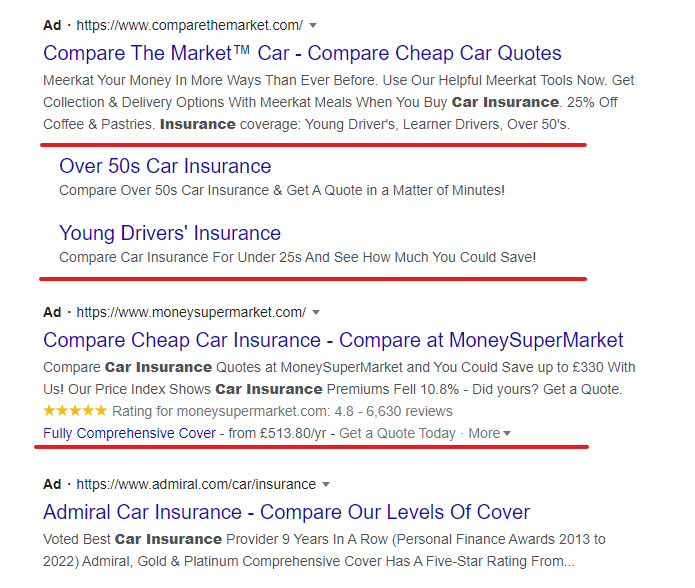
#4 Key phrases
Semantics research will help you find promising keywords for your site. Keywords are the basis of an advertising campaign. How many people will see your ad depends on the correct selection of keywords. Keywords analysis will show which keywords each competitor uses for targeting; relevance of keywords and landing pages; whether brand queries with the name of competitors are used.
This helps make it easier to collect semantics for your advertising campaign. You can also find ideas for new keys
#5 Campaign Budget
The calculation of the advertising budget will give an understanding of what approximate costs your campaigns will have. Many factors influence pricing in contextual advertising; it is not possible to find out the exact budget of competitors in Google Ads. However, this does not exclude the possibility of determining the approximate costs of competing companies.
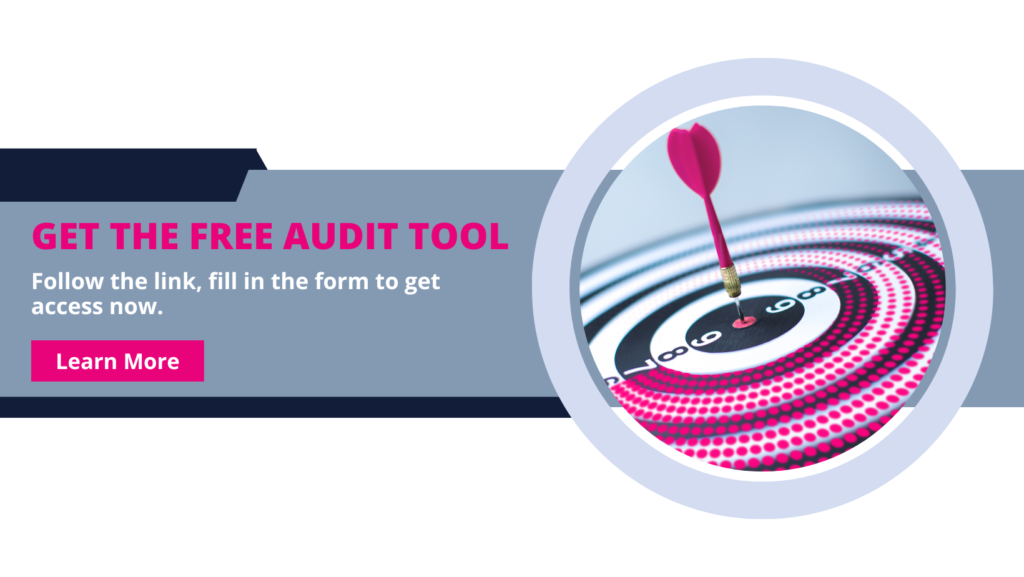
Competitor analysis in Google Ads
After launching an advertising campaign, Google AdWords gives advertisers the opportunity to get information about who is in competition with you for a particular request, whether you are ahead of your competitors or behind. To do this, use the special report “Auction Statistics”.
Auction insights report for Search campaigns
To get to Auction Insights from within your Google Ads account, click on one of these options, depending on what type of data you need to get from your auction insights report:
- Ad groups
- Campaigns
- Keywords
Once you click on one of the three options, you can choose a unique “Campaigns” in the left sidebar and select “Auction Insights” from the menu that appears.
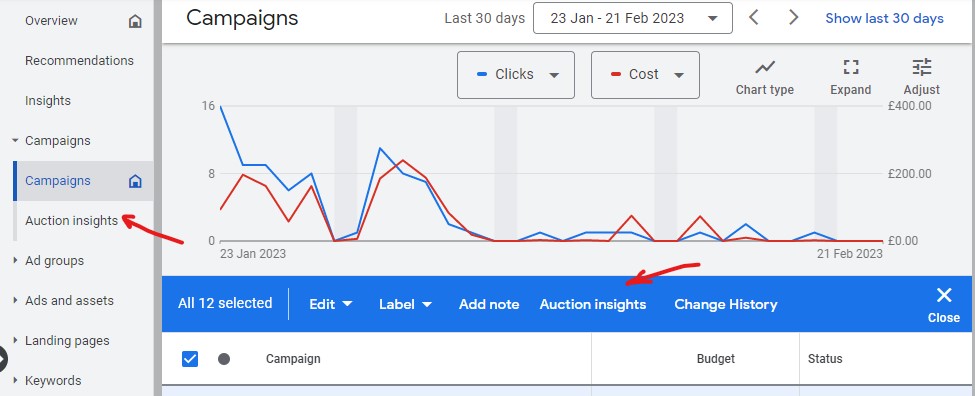
Key metrics in auction insights
- List of sites that are also shown for a specific request or group of requests;
- Impression share – determines the share of impressions that were received in a specific period of time for your campaign and competitors.
Impression share = impressions / total eligible impressions
For example, if your ad has been viewed 2,000 times and 10,000 are available, your share is 20%. - Overlap rate – The overlap rate measures how often your competitor’s ads were shown at the same time as yours. For example, if the rate is 20%, your competitor’s ads were shown twice for every ten impressions of your ad.
- Outranking share – shows how often your ad was higher in the rankings than others.
- Position above rate (search only) – shows how often a competitor’s ad is higher than yours in one search results.
- Top of page rate (search only) – how often your ads was shown at the top of the page in search results with competitors.
- Absolute top-of-page rate (search only) – shows how often your or another advertiser’s ad was shown at the top of the page as the first ad.
If you see non-target competitors, you should pay attention to:
- your keywords;
- their match types;
- search queries for which they are shown.
You may be using untargeted keywords that should be stopped. And perhaps broad match brings in non-targeted queries that should be added to negative keywords. Or is it better to switch the keywords to phrase matching altogether if there are a lot of such queries.
Using Auction insights for better PPC competitor analysis
Auction insights is the main way to review your Google ads competitors for free. To view a report on a keyword or group, select it by ticking the box next to each item, and you will immediately see an additional panel with a button. Then click Auction insights.
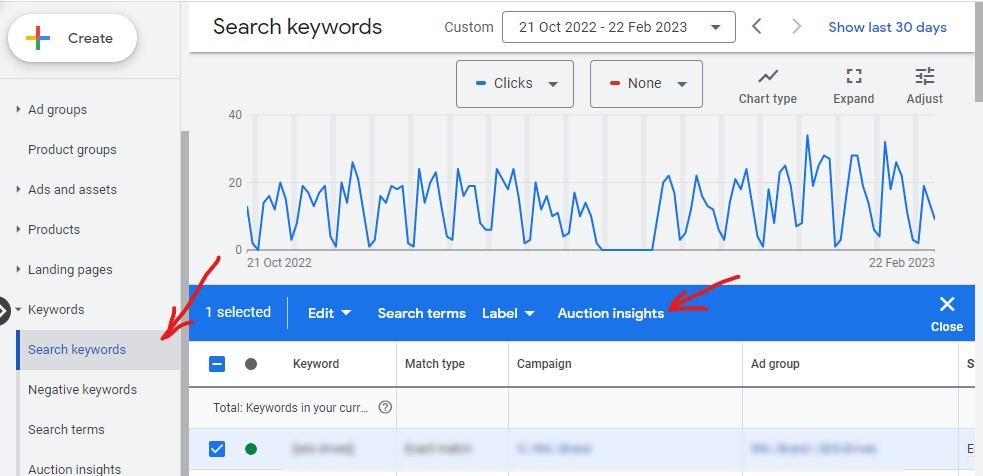
Often this report answers the question, “Why did CPC go up?” which means, accordingly, the effectiveness of the advertising campaign has fallen. Check: perhaps a new player has appeared in the auction or other participants have raised prices.
Let’s say we see that we are seriously inferior to some competitors for a certain request. This request, however, gives a good conversion. So, there is something to fight for. In this case, there is reason to consider increasing the budget.
In the keyword auction statistics, you can track which of the competitors is advertised for your branded query.
Report on auction statistics in Google Ads in dynamics
In the report on auction statistics, there is no way to compare indicators with the previous period by selecting the appropriate function in the calendar. To track the dynamics of how the competition indicators in the auction are changing, you need to go to the “Overview” tab and find the auction statistics dashboard.
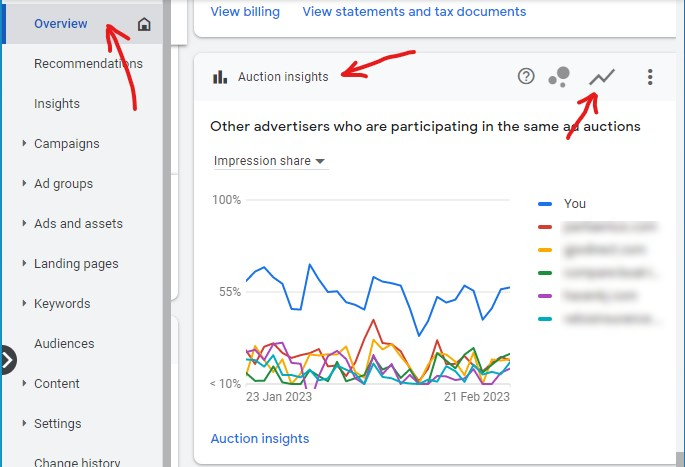
This will display the dynamics of competition indicators over the past 30 days. It is very useful to check when your competitors started to increase their activity. This dashboard is available at the ad group level and above.
Auction insights report for Shopping campaigns
The auction insights report for Shopping campaigns provides 3 different statistics, including: impression share, overlap rate, and outranking share. You can generate a report for one or more ad groups or campaigns (search impression share should be more than 10% in your selected date range or filters.), and segment results by time and device.
To view a report, you need to click on the desired campaign in your account and select “Auction insights” in the “Ad Group” section.

To view statistics for an ad group on the same page, you need to click on the filter, select the required ad group and click “Apply”.

Auction insights report for Performance Max campaigns
The auction insights report for Performance Max campaigns furnishes data on auction insights for Search and Shopping ads displayed on the Search Network from November 2021 onward. This report offers segmented auction insights for both Search and Shopping ads, accessible at both the account and campaign levels.
To view a report, you need to click on the desired campaign in your account and select “Auction insights” in the “Insights” section.

The report proves highly valuable for optimizing Performance Max campaigns, aiding in assessing the campaign’s learning accuracy and its exposure to the intended audience.
You can’t set targeting keywords in Performance Max. The system independently selects for which search queries to show advertising, based on the signals of the audiences and objects that you added when setting up the group. If you notice advertisers among your competitors who are not relevant to your niche, it suggests that your campaign may be optimized using incorrect signals.
What can you do with auction insight data?
With this information, you can assess the performance of your ads, making it a valuable starting point for conducting a PPC audit.
- The Auction insights report will show you your competitors and your current position compared to your competitors, and will also help you improve the effectiveness of your own advertising.
- The report data will help to understand the strategies of your competitors and improve their own advertising.
- You will understand that it is worth raising your bids and increasing your promotional budget if the report is empty because the share of your ad impressions is below 10%. This indicates that your competitors are spending significantly more. Thanks to the report, you will be able to understand how much you need to increase your bids and/or budgets.
- The report will help you determine whether the Performance Max campaign has learned correctly and whether your ads are reaching the target audience. It will also indicate whether the target keywords are being utilized in your search campaigns.
Further advice on Google competitor analysis
As I said earlier, that PPC competitor analysis is an ongoing process. Competitors can change their strategies, and the digital landscape is dynamic and there is a lot of information available to you from different sources. At Atomic Leap, we always recommend regular competitive analysis to give you a competitive edge. For help on setting this up, contact our team today.
Liked the article? Don’t forget to share it on social networks.

ABOUT THE AUTHOR
Wayland Coles is MD and Founder performance marketing agency Atomic Leap, where he helps businesses of all sizes capitalize on the power of PPC marketing.
LinkedIn: Wayland Coles
Google Ads and Facebook Ads are two major players in the digital advertising landscape, each offering distinct advantages and serving different advertising goals. At Digital marketing agency Atomic leap, we bake the scientific approach into everything we do, and competitor PPC, Paid Social are very much part of this.
Understanding Google Ads
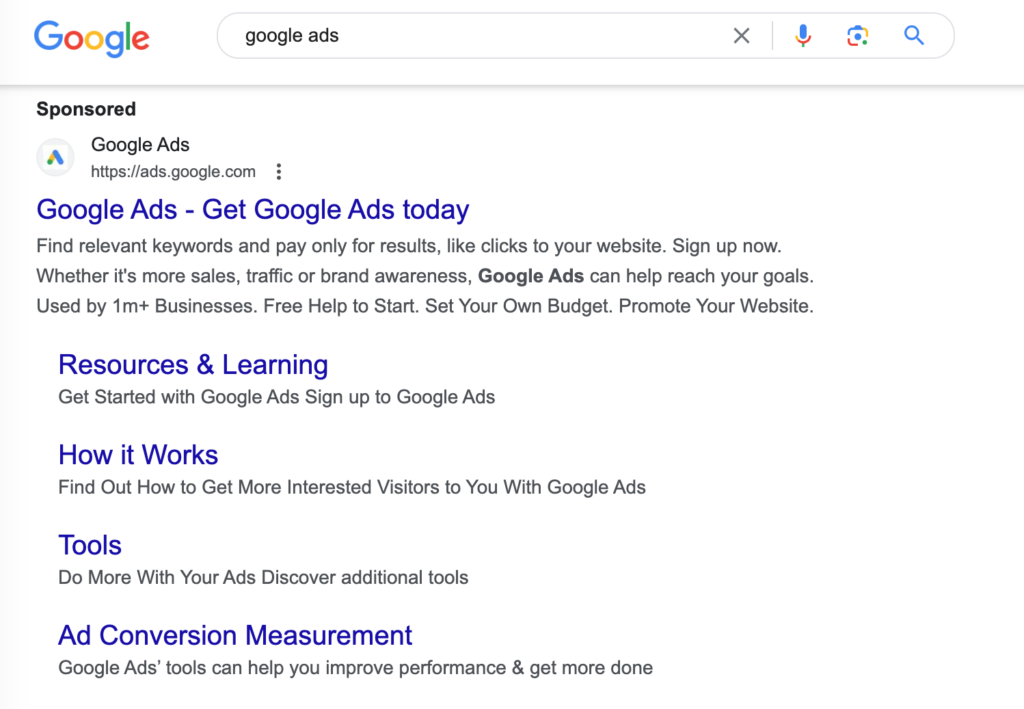
What is Google Ads?
Google Ads is a powerful online advertising platform developed by Google, allowing businesses to display their ads to users across a variety of Google-owned platforms, websites, and partner sites. It’s a pay-per-click (PPC) advertising system, where advertisers bid on keywords and pay when users click on their ads. Google Ads provides a robust suite of tools and features for creating, managing, and optimizing ad campaigns.
Primary Features of Google Ads:
- Keyword Targeting: Advertisers choose specific keywords relevant to their products or services. When users search for these keywords on Google, relevant ads are displayed.
- Intent-Based Targeting: Google Ads excels in intent-based targeting. Advertisers can reach users actively searching for products or services, making it highly effective for capturing potential customers with high purchase intent.
- Ad Formats: Google Ads supports various ad formats, including text ads, display ads, video ads, shopping ads, and app promotion ads, allowing businesses to tailor their messaging to their audience.
- Budget Control: Advertisers set daily budgets, ensuring they don’t overspend. Additionally, they can adjust bids for specific keywords or audiences.
- Ad Extensions: These add extra information to ads, such as location, call buttons, and site links, enhancing ad visibility and relevance.
- Geo-Targeting: Advertisers can target ads to specific geographic locations, ensuring their campaigns reach the right local audience.
- Performance Tracking: Google Ads provides detailed analytics, allowing advertisers to measure the performance of their campaigns and make data-driven decisions.
Strengths of Google Ads:
- Intent-Based Targeting: Google Ads connects businesses with users actively seeking their products or services, increasing the likelihood of conversions.
- Search Ads: Advertisers can appear at the top of Google’s search results, gaining prime visibility when users are looking for related information.
- Vast Reach: Google’s network includes search, YouTube, Gmail, and millions of partner websites, providing extensive exposure.
- Flexible Budgeting: Advertisers have full control over their spending, making it accessible for businesses of all sizes.
Examples of Businesses Benefiting from Google Ads:
- E-commerce Stores: Online retailers leverage Google Ads to showcase products and attract shoppers searching for specific items.
- Local Services: Local businesses like restaurants, salons, and repair services use Google Ads to attract nearby customers.
- Tech Companies: Technology firms promote software, apps, and hardware through Google Ads to reach their target audience.
- B2B Companies: Business-to-business companies use Google Ads to target industry-specific keywords and reach decision-makers.
In essence, Google Ads is a dynamic advertising platform that empowers businesses to connect with potential customers precisely when they are most interested, making it an essential tool for modern marketing strategies.
Understanding Facebook Ads

What is Facebook Ads?
Facebook Ads is a comprehensive advertising platform offered by Facebook, allowing businesses to create and display ads across Facebook and its family of apps, including Instagram and Messenger. This platform enables advertisers to reach a vast and diverse user base while providing an array of tools to design, manage, and analyze ad campaigns.
Core Features of Facebook Ads:
- Audience Targeting: One of Facebook Ads’ standout features is its precise audience targeting. Advertisers can define their audience based on demographics, interests, behaviors, and even custom audiences like website visitors or email subscribers.
- Ad Formats: Facebook offers a variety of ad formats, including image and video ads, carousel ads, slideshow ads, and more, making it possible to create visually appealing and engaging content.
- Budget Control: Advertisers can set daily or lifetime budgets, ensuring full control over ad spending. Bidding options allow for flexibility in optimizing campaigns for specific goals.
- Remarketing: Advertisers can retarget users who have interacted with their brand before, increasing the chances of conversion.
- Detailed Analytics: Facebook provides in-depth analytics and performance data, enabling advertisers to measure campaign effectiveness and refine strategies.
Strengths of Facebook Ads:
- Precise Audience Targeting: Advertisers can reach highly specific audiences, ensuring their message resonates with the right people.
- Visual Appeal: Visual content performs exceptionally well on Facebook, making it ideal for showcasing products, services, and brand stories.
- Engagement Opportunities: Facebook’s social nature allows for direct interaction with users through likes, comments, shares, and messages, fostering community and engagement.
- Cross-Platform Reach: Facebook’s extended network includes Instagram and Messenger, broadening the reach of ads.
Examples of Businesses Excelling with Facebook Ads:
- E-commerce Brands: Online retailers benefit from Facebook Ads by showcasing products through visually captivating ads and targeting users based on their interests and online behavior.
- Local Businesses: Restaurants, salons, and shops use Facebook Ads to reach potential customers in their vicinity, offering promotions and driving foot traffic.
- Brands Focused on Brand Awareness: Companies looking to build brand recognition and engage with audiences through storytelling and visual content leverage Facebook Ads effectively.
- Nonprofits: Organizations seeking donations or supporters can use Facebook Ads to reach like-minded individuals who are passionate about their cause.
In summary, Facebook Ads empowers businesses to craft engaging, targeted, and visually appealing ad campaigns, fostering meaningful interactions with their audience across Facebook’s extensive network of platforms. It has proven to be a valuable tool for businesses aiming to connect with their ideal customers and achieve their marketing goals.
Key Differences Between Google Ads and Facebook Ads
In the dynamic realm of online advertising, Google Ads and Facebook Ads are two giants, each with its unique strengths and strategic focus. Understanding these platforms’ fundamental differences is essential for businesses aiming to maximize their advertising impact.
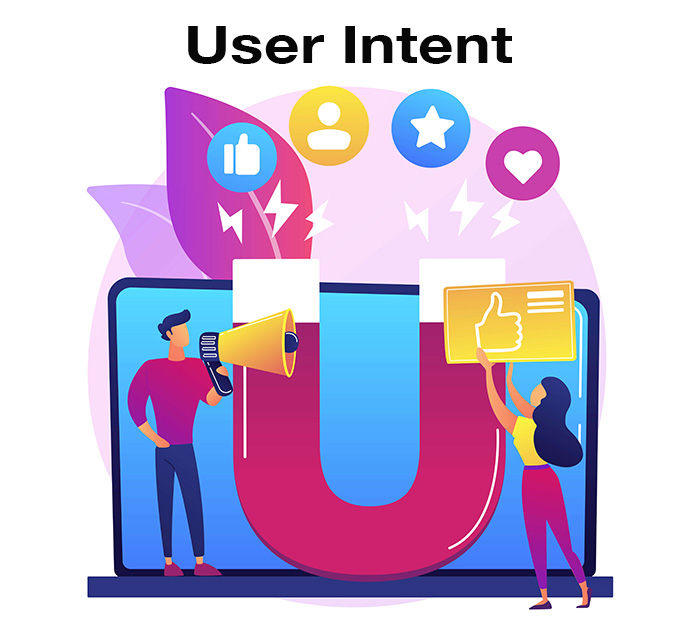
Google Ads: Google Ads primarily taps into user intent. It targets individuals actively searching for specific products, services, or information. Advertisements appear within search results, aligning with users’ immediate needs and purchase intent.
Facebook Ads: Facebook Ads are more about discovery. They engage users based on their interests, behaviors, and demographics, often introducing them to products or services they may not have actively searched for.
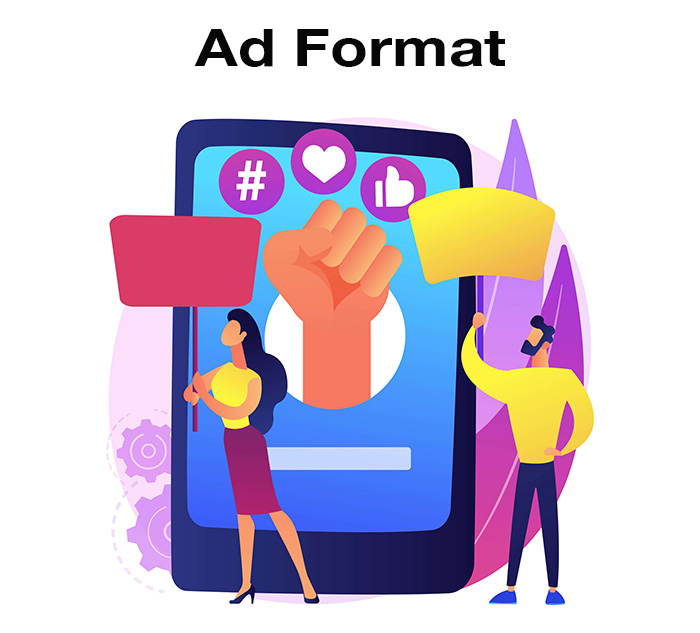
Google Ads: The predominant ad format is text-based, displayed within search results or on websites participating in the Google Display Network. Visual elements are typically minimal.
Facebook Ads: Facebook Ads emphasize visuals, with a variety of formats like images, videos, carousels, and slideshows. This platform excels in delivering visually engaging content.
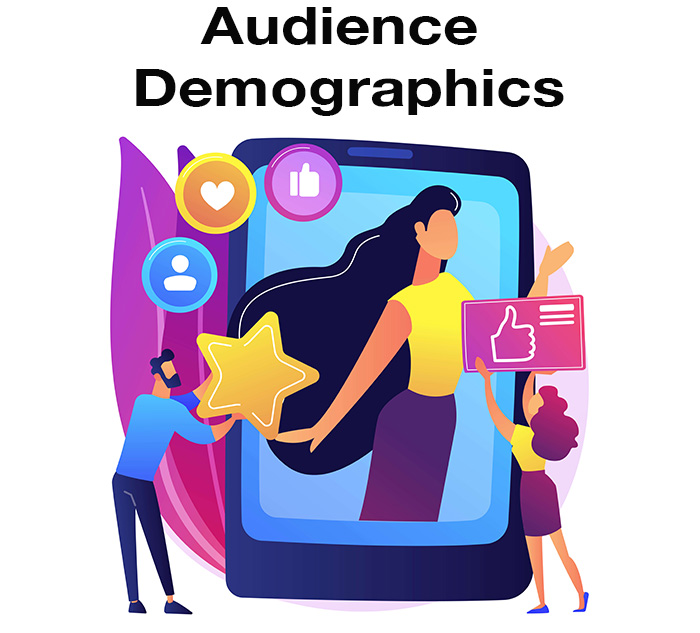
Google Ads: Google Ads’ strength lies in its wide user base, but demographics targeting is less precise. It appeals to a broad range of users actively seeking information or solutions.
Facebook Ads: Facebook offers intricate audience targeting based on demographics, interests, behaviors, and more. Advertisers can reach specific customer personas with tailored messaging.
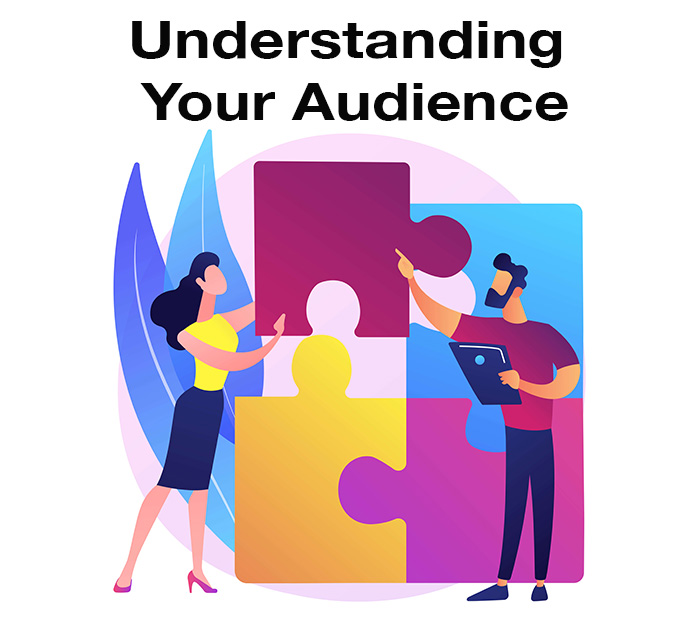
Google Ads: Knowing your audience’s search intent is critical. Craft ads that directly address their queries, offering solutions or products that match their needs.
Facebook Ads: Understand your audience’s interests and preferences. Create visually compelling content that resonates with their lifestyles and aspirations.
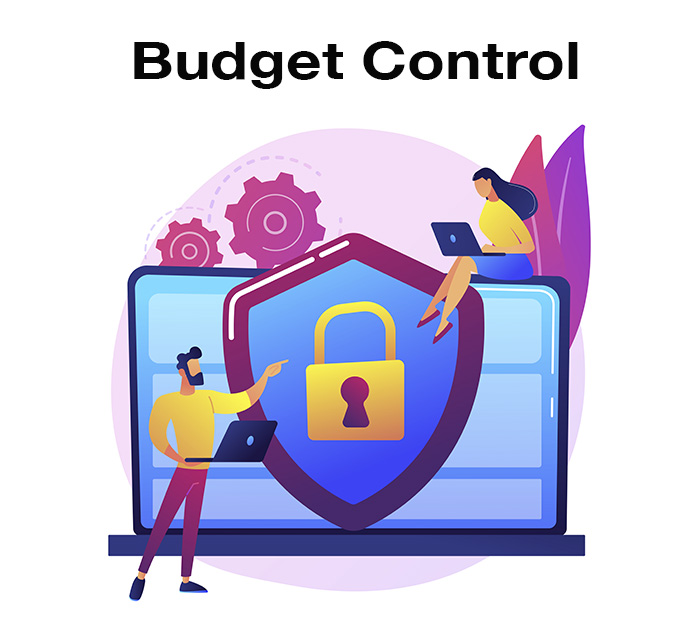
Google Ads: Requires budget allocation for keyword bidding, with potential for higher costs in competitive niches.
Facebook Ads: Provides flexible budget options, making it suitable for businesses with varying financial resources.
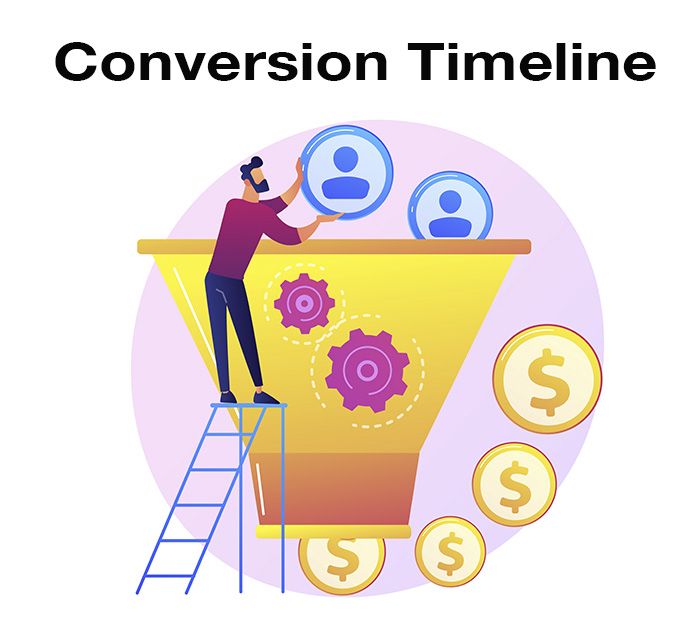
Google Ads: Can lead to quicker conversions due to high user intent.
Facebook Ads: May require longer conversion timelines, particularly for brand building and awareness.
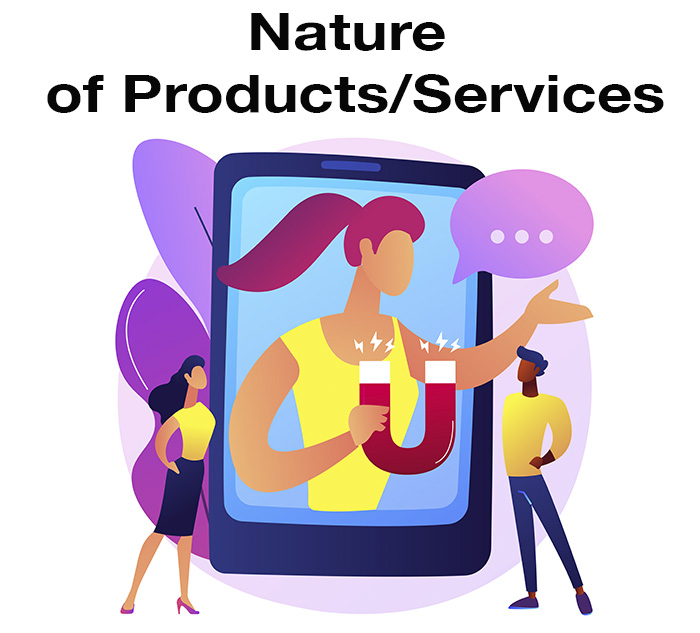
Google Ads: Ideal for businesses with products or services in high demand or with immediate purchase intent.
Facebook Ads: Effective for introducing new or unique products, building brand identity, and fostering long-term relationships.

Google Ads: Influences users ready to make a decision, often near the end of the customer journey.
Facebook Ads: Shapes preferences and influences users at various stages of the customer journey.
Understanding these key differences is essential for businesses to make informed decisions about which platform aligns best with their advertising goals and target audience.
Interested in PPC in Bristol, Paid Social, or both, but not sure how to get started? Hit us up & our PPC & Paid Social team would love to chat with you!
Liked the article? Don’t forget to share it on social networks.

ABOUT THE AUTHOR
Wayland Coles is MD and Founder performance marketing agency Atomic Leap, where he helps businesses of all sizes capitalize on the power of PPC marketing.
LinkedIn: Wayland Cole
In the bustling digital landscape, where businesses vie for online prominence, the choice between Google Ads and Facebook Ads plays a pivotal role in determining a company’s advertising success. Atomic Leap as Bristol PPC agency is well aware of this, as they guide businesses through the intricate world of pay-per-click advertising. But the burning question remains: which platform should your business prioritize?
However, here’s the catch: businesses must choose their stage wisely. The decision between Google Ads and Facebook Ads holds the key to effective digital advertising. Each platform boasts unique capabilities, making it essential for businesses to align their choice with their specific goals and objectives. As we delve deeper into the world of online advertising, we’ll navigate the intricacies of these giants to help businesses make the right call for their success.
Facebook Ads vs Google Ads
Platform | Facebook ads | Google ads | ||||||||||||||||||||||
Average Cost per Click (CPC) | 97 cents | 1-2 $ | ||||||||||||||||||||||
Average Click-through Rate (CTR) | 1.32% | 4.85% | ||||||||||||||||||||||
Average Cost per 1,000 Impressions, or CPM $11.69 Facebook* $10.41 Instagram* $3.12 Average Cost per Lead (CPL) $10.94 Facebook* $12.78 Instagram* $40.74 Average Click-through Rate (CTR) 0.90% 6.30% Average Conversion Rate 9.21% 7.26% User Intent Passive: Audience may not be actively looking or ready to buy Active: Audience is actively searching and ready to buy Targeting Basis Interests, demographics Keywords, search intent Ad Types Image, Video, Slideshow, Carousel, Collection, and Instant Experience Organic results, Call-only, Shopping Ads, Service Ads, and Remarketing Display Ads |
Differences in Campaign Features
Facebook Ads and Google Ads are two prominent advertising platforms with distinct features and capabilities. Here are some key differences in their campaign features.
Platform | Facebook ads | Google ads |
Advertising Goals | Facebook offers a wide range of ad objectives, including brand awareness, engagement, website traffic, lead generation, and e-commerce sales. | Google is primarily focused on search and display advertising, with goals like driving website traffic, increasing sales, and generating leads. |
Ad Networks | Facebook, Messenger, Instagram, and Audience Network | Google search, display, shopping, remarketing, and local service ads |
Audience Intent | Passive | Active, users with high purchase intent |
Ad Targeting | Audience | Keywors for search campaigns and audience targeting for display campaigns |
Audience Targeting by Location | ✓ | ✓ |
Audience Targeting by Behaviors, Interests, or Demographics | ✓ | ✕ |
Ads With Images | All Ads | Shopping and remarketing |
Video Ads | ✓ | ✕ |
Ad Scheduling | ✓ | ✓ |
Negative Keywords (to Exclude) | ✕ | ✓ |
Automatic Budget Optimization | ✓ | ✓ |
Remarketing Ads | ✓ | ✓ |
When to Use Facebook Ads

Facebook Ads can be a powerful addition to your digital marketing strategy in various scenarios. Here are some situations when you should consider using Facebook Ads:
- Building Brand Awareness: If your primary goal is to introduce your brand to a new audience or reinforce your brand’s presence among your target demographic, Facebook Ads can help by reaching a wide user base.
- Promoting Content: Facebook Ads are an excellent choice when you want to promote blog posts, articles, videos, or other content to a specific audience. This can help increase website traffic, engagement, and brand authority.
- Lead Generation: If you’re looking to collect leads for your business, such as email sign-ups or inquiries, Facebook Ads offer lead generation campaigns that allow users to submit their information directly through the ad.
- Product Sales: E-commerce businesses can benefit from Facebook Ads when looking to boost product sales. You can create dynamic ads that showcase your products to users who have shown interest in them.
- Event Promotion: Whether it’s a webinar, product launch, or in-person event, Facebook Ads are effective in promoting and driving attendance to your events.
- App Installs and Engagement: For mobile app developers, Facebook Ads can be used to promote app installs and engagement. You can target users who are more likely to download and interact with your app.
- Remarketing: Facebook Ads are valuable for retargeting users who have previously visited your website or engaged with your app. You can remind them of your products or services, encouraging them to return and make a purchase.
- Local Business Promotion: If you have a physical store or offer services in specific locations, Facebook Ads can help you reach a local audience. You can even set up ads to drive foot traffic to your store.
- Seasonal Campaigns: During holidays or special occasions, Facebook Ads can help you run targeted campaigns to capitalize on seasonal trends and boost sales.
- Testing and Learning: Facebook Ads provide a cost-effective way to test different ad types, audiences, and strategies. You can gather valuable insights to refine your marketing approach.
In summary, Facebook Ads are versatile and can be used in a range of scenarios to achieve various marketing objectives. It’s essential to align your choice to your specific goals and target audience for the best results.
When to Use Google Ads
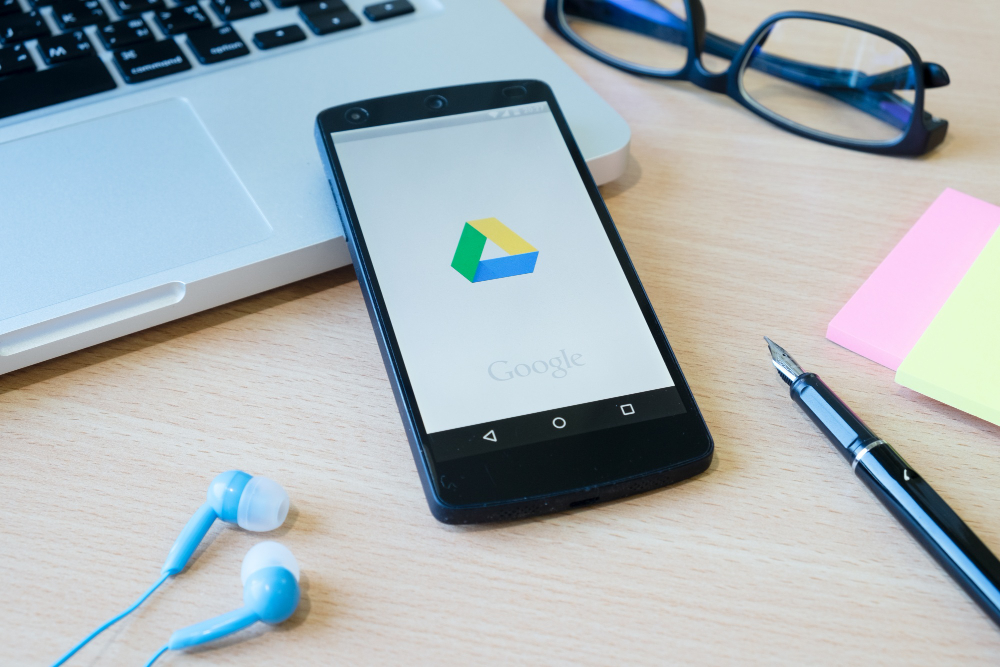
Google Ads is a versatile advertising platform that can be highly effective in various situations. Here are some scenarios in which you should consider using Google Ads:
- Search Intent: Use Google Ads when you want to target users actively searching for specific products, services, or information. Google is the go-to platform for capturing users with high purchase intent.
- Keyword Targeting: Google Ads is ideal for keyword-based targeting. When you have a list of keywords relevant to your business, using Google Ads allows you to bid on those keywords and appear in relevant search results.
- Quick Results: If you need immediate results, Google Ads can provide fast visibility. Your ads can be up and running within a short period, making it suitable for promotions, sales, or urgent marketing needs.
- E-commerce Sales: For online retailers, Google Ads can be an excellent choice for driving e-commerce sales. You can create shopping ads that showcase your products, prices, and availability.
- Local Business Promotion: If you have a physical store or offer services locally, Google Ads can help you target users in your area. It’s especially valuable for attracting foot traffic and driving local sales.
- Remarketing: Google Ads offers powerful remarketing capabilities. You can show targeted ads to users who have visited your website, encouraging them to return and complete a desired action.
- Competitive Advantage: If your competitors are using Google Ads, not using it could put you at a disadvantage. It’s crucial to maintain a presence where your competitors are advertising.
- Seasonal Campaigns: Google Ads is effective for running seasonal campaigns. Whether it’s for holidays, special events, or limited-time promotions, you can reach users at the right moment.
- Lead Generation: Google Ads offers lead generation campaigns that allow users to submit their information directly through the ad. It’s suitable for businesses looking to collect leads and inquiries.
- Specific Audience Targeting: You can refine your audience targeting using various options, including demographics, interests, and more. This precision is valuable for reaching your ideal customers.
- Data-Driven Marketing: Google Ads provides extensive data and analytics, enabling data-driven decision-making and continuous optimization.
- Testing and Learning: Google Ads is an excellent platform for testing different ad types, ad copy, keywords, and bidding strategies. It allows you to gather insights and refine your campaigns over time.
In conclusion, Google Ads is a valuable tool for businesses looking to drive immediate, high-intent traffic, whether you’re focused on sales, lead generation, or local promotions. The key is to align your Google Ads strategy with your specific goals and target audience for optimal results.
Which is better: Google Ads or Facebook Ads?
In summary, the choice between Facebook Ads and Google Ads depends on your specific advertising goals, target audience, and the nature of your products or services. Some businesses benefit from using both platforms to cover different stages of the customer journey and reach a broader audience.
Interested in PPC in Bristol, Paid Social, or both, but not sure how to get started? Hit us up & our PPC & Paid Social team would love to chat with you!
Liked the article? Don’t forget to share it on social networks.

ABOUT THE AUTHOR
Wayland Coles is MD and Founder performance marketing agency Atomic Leap, where he helps businesses of all sizes capitalize on the power of PPC marketing.
LinkedIn: Wayland Cole
Take Advantage of Granular Search Remarketing Audiences
Search Remarketing has been a highly successful tactic in AdWords since launching, allowing advertisers to target highly motivated users already familiar with their brand or service. At PPC marketing company Atomic Leap we are always testing different ways remarketing can work for our clients, segmenting our audiences based on varied customer behaviour factors.
Remarketing Lists for Search
By using the target and bid setting in your search remarketing audiences, AdWords allows you to only target previous visitors to your website who are actively searching again. By creating entirely separate campaigns with targeted audiences, highly targeted and individual ads can be used as we already know this person is more than likely a highly motivated searcher.
To take this tactic into advanced territory we would recommend creating audiences based on several different factors:
- Days since last visit to site
- Non converter/converter
- Basket abandoner
- Engaged users (time on site/ pages viewed)
- Device used
Based on what type of website and service you provide, there could also be many other ways to break down your audiences, such as a user who spends an above average amount on a product or whether they have purchased multiple times.
Days Since Last Visit Audiences
Using audiences defined by days since last visit can be a highly effective way of marketing your service – as each day that passes results in a different mindset or motivation from the visitor. Users that visited just 1 day previously are likely to remember your brand and are also highly motivated, as they are searching for the same service again. The likelihood of the users having found what they wanted already, after searching again for the same thing, is very unlikely so these users should be a key target. Once this audience has been defined you can then optimise your ad messaging alongside testing increased bids and even users journeys on the website – to increase potential returns.
Audiences at the other end of the scale, such as 30 days+ are less likely to remember your brand, so it would be a great tactic to create ad messaging that really stands out – perhaps offering these users an individual incentive to entice them back to the site. The fact that they are still searching for a related service or product shows that they are still in the market for this – so should still convert well.
We have seen great results with this tactic since we implemented days since last visit audiences. We’ve seen conversion rates 70% higher compared than standard search campaigns – making them a profitable target.
Individual Incentives
By creating audiences that recognise users that have signed up to a certain point on the website and then abandoned their prospective sale or membership can be targeted individually – driving them back to the site with a fresh new incentive.
This tactic can be tailored towards basket abandonment on websites – as users add specific items to their basket but don’t complete the purchase cycle. By reminding these specific users via tailored ad messaging and optimising bids, they can be enticed back to the website that they are familiar with to potentially complete their purchase.
One of Atomic Leap’s clients generate memberships via their PPC campaigns, offering users the chance to sing up as a free “basic member”, before they become a fully paid member – and then being able to access the whole of the service. By creating this first free membership stage, it allows us to tag this audience and target these motivated users specifically. By offering this audience individual discounts, such as a percentage of their first month or year, it makes the users feel that their basic membership has provided them with an exclusive offer and are therefore much more likely to convert.
Bu using these they advanced audiences remarketing tactics we have seen many great results in terms of profit generation – seeing one specific campaign achieve 72% higher conversion rates compared to the account average.
Keyword Targeting
Because you know these users are highly motivated to find a service related to what you offer, you should now be able to try more broad match keywords, giving you a greater reach in the search market.
For example, if your current campaigns include keywords such as “Holiday cabin in North Devon”, you could now try out more generic terms in your remarketing campaigns such as “holiday Devon”, or even “holidays”, as we know this user is still searching for their vacation.
By using this search remarketing tactic with one of our clients, we are able to reach an audience that we would have previously missed out on – adding valuable revenue income from their PPC campaigns. Despite advertising on more generic terms, these campaigns converted at a 35% higher rate compared to the other non-brand search campaigns as well as having a significantly higher value per sale.
Don’t Exclude Potential Repeat Business
One mistake that a lot of advertisers do is to exclude already converted customers from their remarketing efforts – as they believe these users are unlikely to buy from them again within the next few months. Although this may be the case for some products and services, it would be a mistake to write off these users completely.
If you sell individual products and update stock regularly, you could miss out on potential repeat customers, as well as referral business as the users look online with friends or family, recommending your product. As well as this, your product may have a certain shelf life – and customers may return to replace their item after a certain amount of time.
Effective remarketing will only work if your website is tagged up correctly – alongside how well the remarketing lists are set up, dependent on what you want to target. Advanced audiences will be most successful if the website has a large amount of traffic, allowing you to break down these users down to highly specific groups.
If you’re interested in discussing advanced remarketing for search and how you can drive more profit from your PPC campaigns, PPC marketing agency Atomic Leap will be happy to help.
Please give us a call on 0117 239 0030 or email me [email protected]
One of the reasons I was drawn to paid search was the huge scope for measuring what you do. And because of that, testing, measuring and refining our work have always been at the heart of our approach at online performance marketing agency Atomic Leap.
By no means everyone does this properly, and you can get so far without doing so. But at some point, you will need to measure properly to get the most from your paid search. And if you are high growth – the sooner, the better.
Your outputs directly relate to your inputs
What you measure in Google ads directly contributes to how much you get out. Because anything you can measure, you can improve and optimise.
Do you want to maximise volume of sales? You can do that. Do you want to reduce bounce rate? You can do that too. Or do you want to generate more profit for your business? Guess what, you can also do that.
By measuring this, then you can optimise towards it in Google.
Combining Google Ads and Google Analytics is a highly flexible and effective way to create meaningful conversion goals linked to your business objectives. These can make a real impact on your business.
Google Analytics
You can measure virtually anything that happens on your website via google analytics and then work towards optimising it. Whereas Google Ads is great for giving you data about what happens before people click, Google Analytics is powerful for informing you what happens after the click. Using them together gives you a far fuller picture. Let’s focus in just two things you can measure and optimise in Google Analytics: Call tracking and business KPIs.
Call tracking
If inbound telephone calls are an important part of your business development, then you should definitely be measuring those. Call tracking tech used to cost a lot, but with a range of competitors and new solutions this can now be done relatively cheaply. It’s not the easiest thing to do without support (either in-house expertise or an agency), but it is absolutely something that Web Atomic can help with.
By tracking telephone calls in Google Ads you can even link offline sales data to online metrics to see which keywords or ads drive the telephone calls.
KPIs
When you think of measuring PPC performance, you could be forgiven for immediately picturing click through rates and quality scores and the like. After all they are in your face on the dashboards. But like other forms of digital marketing you really need to be measuring the solid business KPIs, not being seduced by vanity metrics.
So if you know you want a certain type of sale then start measuring and optimising it. Whatever your KPIs are, that is what you should try to optimise towards, and it is better to be ambitious than cautious. This clarity of thought can bring tremendous focus to a paid search strategy. One of our mantras at Web Atomic is that not tracking conversions is a PPC sin of the highest order.
Now let’s look at how you can add much more insight to the way you measure clicks.
How attribution models can help you
The easy thing to do when measuring click through rate is to score it directly against the advert on which your leads click. This is known as a “last click” basis. Sometimes, when you have limited paid search activity this may be sufficient. But when you are running multiple campaigns, or have been advertising over a long period of time, this may oversimplify the results. This means that you could miss out on important opportunities to refine your campaign.
This is where attribution models can help. If you don’t know, attribution models are used to understand how the credit for a “click” should be allocated over a number of advert impressions. Used correctly, it can give you much better insight into how the decision to buy was made in the customer journey. So let’s take a look at how you can get away from analysing your click through rate on a last click basis.
Using Google Ads attribution models to get away from a last click basis
Within Google Ads, there are a range of attribution models to help you understand how you achieved your clicks:
- Last click – As mentioned above, this gives the credit for the click to the last ad and keyword that was clicked.
- First click – This gives scores the click entirely against the first ad and keyword which was clicked.
- Linear – This evenly splits credit amongst all ads and keywords which were clicked.
- Time decay – Using a seven-day half-life this weights credit towards more recent clicked ads and keywords.
- Position based – The first and last ads/keywords receive 40% of the credit each, with the middle ones sharing the remaining 20%.
- Data driven – Only available to accounts with enough data, this uses past conversion information to calculate how credit should be attributed.
Google has a feature which lets you compare side by side how different attribution models change the picture. This can help you dig a little deeper to get all the information available and also select the right attribution model for you beyond “last click”. The information you glean can be used to improve your bidding on future campaigns.
As you would expect, we do this on all the campaigns we work on. So if you would like to have a conversation about how we can help you with your metrics, do please get in touch
Like just about anyone who has spent time on a PPC strategy, you’ve probably come across targeting options on Google (keywords) and Facebook (audiences) which you know have conversions in them, but you just can’t get these targeting options to perform at the required level.
While you should always go after the targeting options which seem immediately most profitable, this blog post is about how to unlock the unattainable, high volume targeting options too. Because, at pay per click agency Atomic Leap, we have found that you can increase your ROI by five times and more on a campaign, by unlocking the “other” targeting options in your strategy and carefully following some good practices.
Conversion rate optimisation
Conversion rate optimisation, or CRO for short, of your website is one of the most important aspects of your PPC strategy. It is a system of continuous improvement for enhancing conversion rates on your website, and so getting more out of your PPC spend.
You can create two different pages and begin split testing to see which has the highest conversion rate. You can test anything, like the form layout or the call to action button for example. The benefit of CRO is that it increases conversion rates, because you are always opting for higher performing variables as you uncover them. This makes the PPC campaign more profitable generally, but also allows you to bid on keywords it didn’t previously make sense to bid on – because your campaigns become more efficient.
Let’s see how this can work. We’ll now focus on the impact that CRO can have, rather than an overview of CRO itself.
A tale of two keywords
You have two keywords, one immediately converts profitably, the other doesn’t. You correctly reap the returns you are getting from the successful keyword and ditch the one that isn’t working. This is the right thing to do.
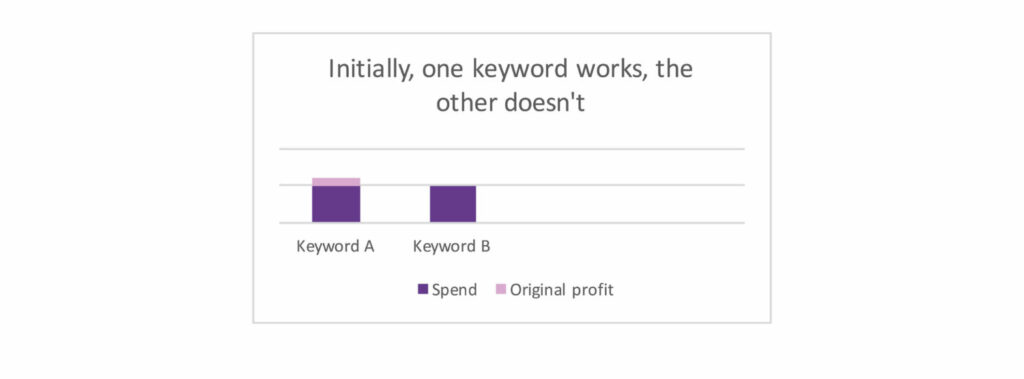
How CRO can transform your campaign
By taking a scientific CRO approach we can both improve the performance of the keyword that is already working and also make the second keyword a viable target.
Step by step, we test every conceivable variable (e.g. the CTA buttons, headlines etc.) on the page. Each “winner” is fed into future iterations of the page and eventually tested against other possible improvements. Over time each component of the page becomes more and more efficient for your campaign. You could say it is like a turbo-charged form of Darwinism.
Two interesting developments
Taking this approach does two interesting things. First, it turns good initial results on keyword A into great (and ever improving) results. And second, keyword B, which we can now test again, starts to deliver profitable gains.
This is the platform that’s needed to really start growing that ROI. Because once you have a bit of traction with keyword B, you can continue optimising it’s performance too. This will drive further profitability on the account.
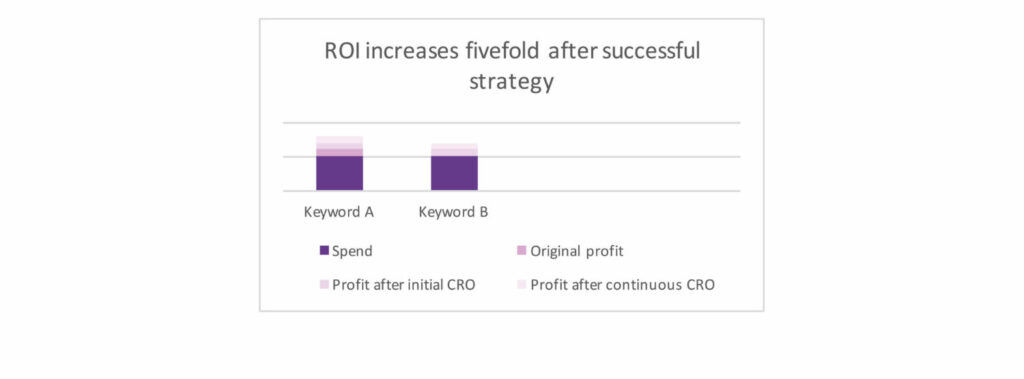
And all from taking a scientific approach to improving conversion rates, and re-testing a keyword that previously didn’t work for you. It is no exaggeration to say that you can grow your return on investment fivefold by executing this kind of strategy well. Just what any high-growth business should be demanding from its PPC spend.
You don’t, of course, need me to tell you that a dedicated landing page can be an essential component of a PPC strategy. The part where those clicks are turned into customers – or whatever outcome you are trying to achieve.
But as best practice evolves over time, what should businesses and other types of organisation be including in a landing page in 2022 – especially given the extraordinary times we are living in.
On that point, there is always pressure on budgets but now especially, with so much uncertainty around, you really want to ensure you are getting the most bang for your buck from your PPC spend.
So optimising the landing page should be one area of focus. At internet marketing agency Atomic Leap, our ethos is to take the scientific approach in everything we do – developing hypotheses and then testing them rigorously to continuously refine campaigns. A/B testing the landing pages is an important part of this. So everything I am about to look at should be seen through the prism of this testing.
What are you trying to achieve with your landing page?
This is an essential question to ask of your campaign. It will often be to make a sale or capture enquirer data when requesting product information. So the design of the landing page will include strong CTA mechanisms for whichever goals are relevant.
However do remember that your conversion will be a long way off 100%. So, you want to create value for yourself and the visitors who do not convert. You can do this through giving them a good user experience, displaying strong branding and including contact details for other sales channels so they have the option of buying (or taking another relevant action) in their own way later on. Providing such contact details also helps to build trust.
Let’s move on to five traits which good landing pages should have in 2022.
1. Landing page relevance to your ad and the enquirer intent
Relevance is absolutely vital to any PPC activity. People are visiting a page with a direct goal in mind so you need to serve that up to them and serve it up clearly so they can see it is what’s on offer. I find that you only have 8 seconds max to make an impression. Relevance is achieved through ensuring a logical continuity between the ad copy and the landing page headline – often having them identical. And having CTAs which match the buying intent – so “Buy now” or “Request a guide” for instance – are important too.
If there is a time-sensitive nature to your landing page, make sure it is updated or replaced at the appropriate time, as arriving at a dated landing page will kill relevance and therefore conversion.
Failure to do this will not only damage your conversion rate, but can also lead to you being adversely affected by the ad host’s algorithms.
2. Great visuals
Research from Xerox found that users are 80% more likely to read content which is supported by images. Stock photos just don’t cut it in 2022, people see right through them. Relevant bespoke photography can create an emotional connection between you and the visitor, so consider who your audience are and what it is they seek and reflect this in the imagery. Beyond photography, good design not only conveys quality, but also aids navigation and user experience. Video is increasingly used. Again ensure high quality production and that it is short and sharp, as attention spans are short nowadays.
3. Compelling copy
Your copy needs to be persuasive of course, but there is much more than the tone and messaging to consider on a good landing page. Quantity for starters: you want to convey enough detail without making the page look wordy which is an immediate turn-off. Make use of devices like headlines, sub heads, bullets and break out boxes to deliver key messaging effectively whilst managing the space on the page.
If you need to provide more detail – and for high cost/commitment decisions it may be necessary – tabs or concertinas are a good way of ensuring it does not get in the way of the call to action. A good rule of thumb is to be aiming to provide just enough information for the user to take the next step.
4. Social proof
When shoppers are considering their options, they don’t just want to hear how great you think you are. They want this reinforced by what others think. So if you have won awards or other customer satisfaction metrics get those logos on your landing page. Include testimonials from other customers and share stats or facts which present your product as the attractive choice that it is.
5. Streamline their journey
Your visitor comes to your landing page for a specific reason. And you want them there for that specific reason. So minimise their opportunity for doing anything other than following your CTA.
In normal web navigation, your logo would lead to your home page. This is a no-no on your landing page where everything should be directing the user towards your CTA. The same goes for clickable graphics and navigation bars. The latest research shows that 84% of landing pages still have navigation bars, when the whole point of the landing page is to focus attention on a single offer.
Test and trace performance
I said it at the beginning and it is so important that I’ll say it again. A scientific approach pays dividends, so A/B test as much as you can on your landing page as often as you can. Industry research, and I find it is true in our own work at digital media agency Atomic Leap, finds that conversion rate optimisation tools increase return on investment by 223% on average. No-one is going to get it exactly right first time but with continuous testing and tweaking you will continue to drive performance gains in your campaign.
One thing that has me tearing my hair out is the myth of the PPC plateau.
And if you’ve experienced it as a marketing director, entrepreneur or in some other role, you’ve very likely been tearing your hair out too.
You’ve started some PPC campaigns. You’ve enjoyed some success. And for a while the numbers keep going up. But then they level off. And you can’t say it is inexplicable because your agency has explained it. But really it is a myth.
The thing is of course, you need the numbers to keep going up. Whether it is your own ambition, external pressures, or both, you need more.
The good news is that with the right expertise and tools you can bust through your plateau, proving it to be a myth.
Indeed, we look after clients who have been with us since 2010, who are still seeing an annual profit increase of 15%-20% through the unrelenting techniques we use.
A fresh pair of eyes
While in my perfect world you’d be picking up the phone to performance marketing agency Atomic Leap, you don’t of course need to immediately change agency to get a fresh pair of eyes on the account. Whether it is someone in your in-house team or from your current agency, get someone else to look over the account if the account has plateaued. Cliches are created for a reason so there can be truth in the saying “one can’t see the wood from the trees”.
If someone has been working on your PPC for a long time and it is not progressing they might be so caught up in it that they are missing something obvious. There is no shame in getting some new perspective.
It’s one of the reasons we always work in teams on each account we manage.
Making changes to the website
If you haven’t run any conversion rate optimisation on the website, then this could be the first action to take to break through the plateau.
Running split tests can boost conversion rates and give you greater purchasing power through your advertising campaigns.

Shifting sands
Like many other areas of marketing, PPC is constantly changing. While this is frustrating to some, it presents fantastic opportunity for you and agencies which have the energy to keep abreast of the latest trends.
So if you have reached that plateau, ensuring you are following the latest best practices is a go-to approach to breaking through it. You could consider ideas like new markets, new platforms, new tools… Each one could be the right path to take your PPC to the next level, and over time you might explore all of them.
Let’s look at introducing a new platform in more detail, and how it’s possible to treble a return on investment. There was a time when YouTube wasn’t great for PPC because only site-wide targeting was available – not specific video targeting. But this changed and we can now, of course, use YouTube Video Targeting Tools in combination with other technology platforms.
I remember one campaign that caught my eye was that of a designer fragrance business which used this functionality to match celebrity videos on the YouTube platform to celebrity branded perfume PPC adverts, because there was a strong link between the viewers’ watching habits and purchasing preferences. The result? There was 100% relevance of the adverts to the users and the company enjoyed a 236% ROI. Not bad figures for overcoming a plateau reached on existing platforms.
A scientific approach
This one is very close to the heart for us at digital performance marketing agency Atomic Leap. It is not of course unique to us, but the meticulous approach we take does set us apart from the vast majority of PPC agencies. Continuous split testing, in-house algorithms developed by a PhD and a focus on ROI means it is in our mindset never to settle for the PPC plateau.
When there is constant refinement in the campaigns from audience, to keywords, to landing pages and beyond, there is always opportunity for the graph to continue upwards – and quite frankly, we don’t think clients should settle for anything less.
In one example we worked on, we took over a poorly performing account which was being run for The HGV Training Company. We rebuilt the account for maximum statistically valid testing, and introduced dynamic landing pages. In the first three months we increased the volume of leads 16-fold, whilst reducing the cost per lead by 90%. While the biggest gains were made early on, we have continued to improve performance with no plateau in sight! You can read the full case study here.
One final point
When you hear conversation about a plateau, you may be more relaxed about it if you have plateaued in a good place. You are making money after all. But this is a pitfall to at least be aware of, and actually we would say avoid. First for the opportunity cost of not growing the account when it is possible to do so. And second because, eventually you may not be so comfortable on that plateau. By then there will be a lot of catching up to do.
Why use Google Ads Editor?
We are pleased to present the expert opinion of Atomic Leap’s ppc specialists. For individual ads, when adding just a couple of new ads into an account, you can do it straight from the Google Ads interface. However, when uploading many ads across multiple campaigns and ad-groups, it can be much easier to use the Editor. This is because you can create ads much quicker in Excel, then upload them all in one go using the editor.
5 Google Ads Editor Benefits
- The editor can also let you see how everything will upload before putting it into the account, avoiding mistakes.
- The editor makes it easier to visualise the account structure.
- It makes it easier to edit settings and add items such as keywords and ads.
- It allows you to copy and paste items easily.
- It doesn’t set anything live until you post, so you can create campaigns, ads etc and check over the structure before actually setting it live – overall just giving you much more control compared to the browser interface.
What is bulk uploading with the google ads editor?
Bulk uploading is using a sheet of data to import an array of items the into google ads editor, making it much quicker and easier than using the browser interface.
How To Use Excel To Create Google AdWords Campaigns?
For the google ads editor to convert your Excel sheet into ads, you will need the necessary column headers. The required ones will be:
- Campaign
- Ad-group
- Headline 1
- Headline 2
- Headline 3
- Description 1
- Description 2
- Final URL
However, we recommend you also add:
- Headlines 4-15
- Descriptions 3-4
- Path 1
- Path 2
- And if you need it, Labels
- Headline and description positions (such as “Headline 1 position”)
What should my sheet look like?
Here is an example of how the sheet should look

Once you have your headers, you can create an ad per row. You can drag the rows down to get the same ad sections across multiple rows for your list of ad-groups. From here you can change the parts that need to be unique to the ad-group.
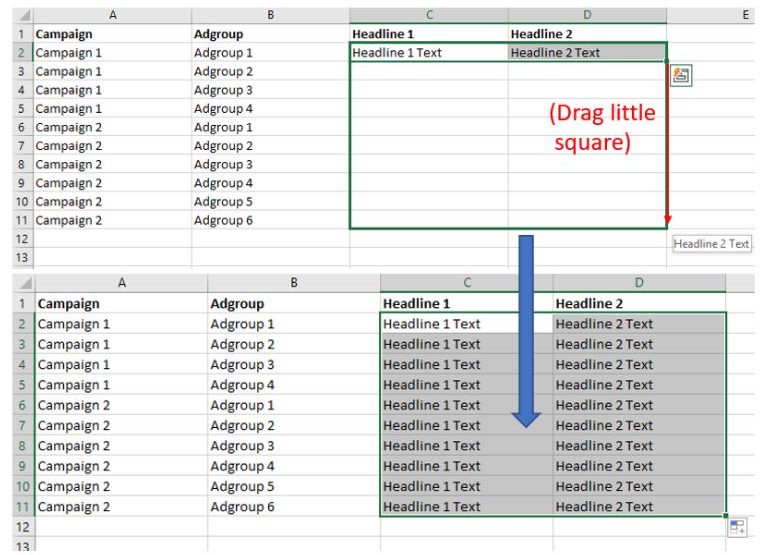
You can also put in an extra column with =LEN(cell) to see the lengths of each part, so that you can check that there aren’t too many characters.
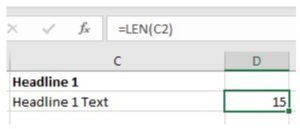
What issues can I prevent at this stage?
In the sheet you want to make sure that the data you have is correctly formatted and is acceptable for Google, here are a few points to look out for:
- Final URL must have https at the start of it
- Ad copy lengths must be within the limits – this is 30 for headlines, 90 for descriptions and 15 for Paths
- Make sure there are no editorial issues, such as phone numbers. Google have a page on this: https://support.google.com/adspolicy/answer/6021546?hl=en-GB
I have created the ads in Excel, how do I get this into Google Ads Editor?
Before you add the ads into the editor, its best to download the whole account first. This makes sure that when you post changes, it doesn’t revert any changes since you last downloaded the account. A shortcut for this is Ctrl-Shift-T.
Importing into the Google Ads Editor:
Now for adding the ads into the editor – which they have made a very simple and easy process now that you have the sheet with the data.
At the bottom left of the editor, in the Manage section under the ads dropdown, click on “Responsive search ads”. Then you can click on the “Make multiple changes” button at the top.
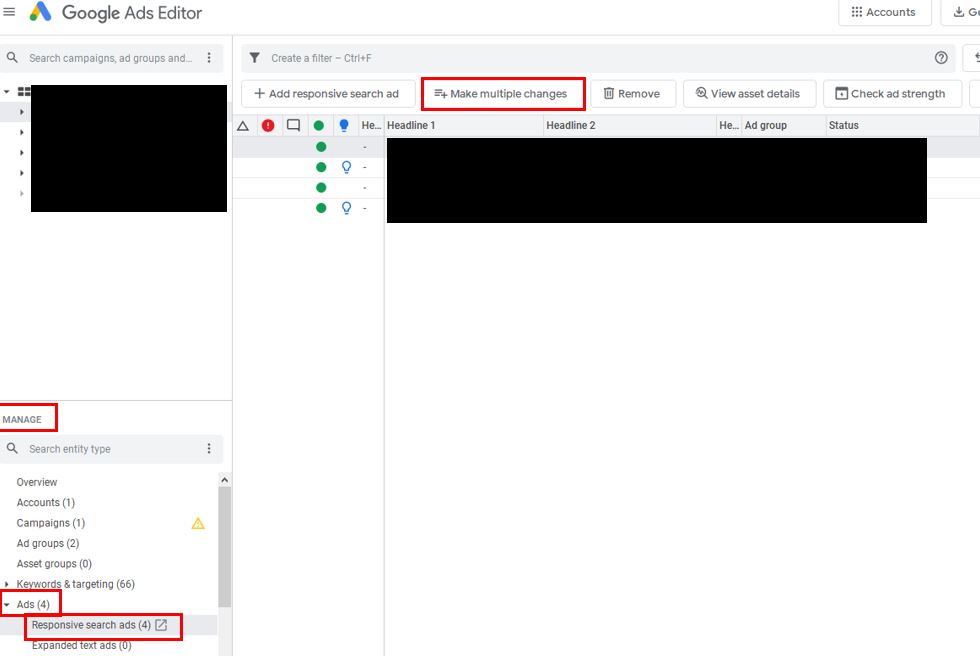
This box will appear, the first thing to change is the Destination, select “My data includes columns for campaigns and/or ad groups.”
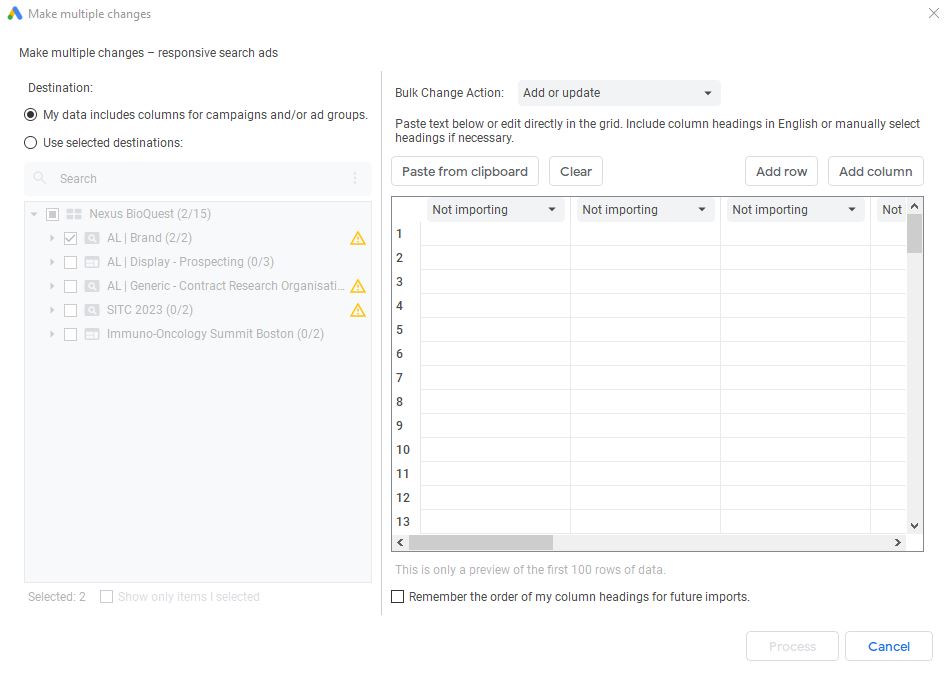
Now go to your sheet, select your table of data (you can use Ctrl + A if the current selected cell is within the table) and in the editor click the option for “Paste from clipboard”.
When it’s finished processing, it will give you a summary of what’s been added, make sure that they all say added instead of modified. If you find that it is modifying existing ads instead, you can stop this by adding a column in Excel called “Headline 1#Original”. Put any value in for this column and it will force the editor to create a new ad instead of modifying an existing one.
My ads are in Google Ads Editor, how do I post them?
Before you post you will want to check that everything is ready to go.
Processing the data:
Now click Process, this will bring up a “changes made” box, showing you what was Updated, Added or Skipped, plus any errors for your data. If everything is as expected, you can finish and do a last check through in the editor before posting your new ads!
Here is a small list of things to look out for:
- Errors – these come up as red or yellow and will tell you want the issue is when you click on them. If they are red, the editor won’t even attempt to upload them.
- That the ads have imported to the correct places. You can see how many ads are in each ad-group/campaign and see if it matches with your plan.
- That no new campaigns or ad-groups were made. If the names were typed wrong in Excel, then it will create a new campaign or ad-group. Anything new is highlighted in bold in the editor.
- That you have paused previous ads if you are replacing any.
If you had errors, you can revert and cancel and make sure the data you are importing from the sheet is corrected before trying again.
What Are Ad Extensions in Google Ads?
Ad extensions are important for making sure that you are making the most of a Google Ads campaign, they are simply just extra pieces of information to attract customers or extra contact options that help make your ads stand out that bit more over competitor’s. The extra useful information can let customers know more about your products or options that you want them to know about, whilst also making the ad visually larger on search results.
A couple of examples are sitelinks and call extensions, these are common and simple, but highly effective when used properly. Their purpose is to increase the number of customers clicking on the ad, improving the click-through rate of your ads and increasing the overall performance of your Google Ads campaign.
This is what sitelinks look like in Google search results:
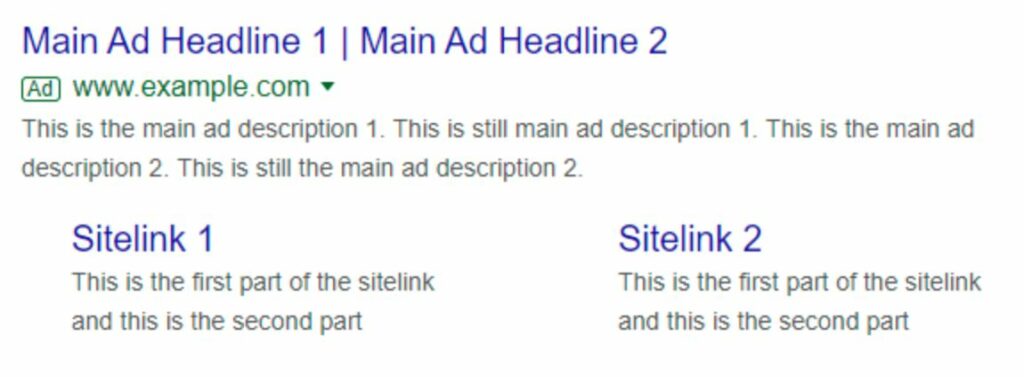
Sitelinks
Sitelinks have extra information and give the option to customers to visit other parts of the site, like different categories of products that they may be interested in. However, sitelinks are smaller than the ads, you only get one headline and 2 descriptions per sitelink. The parts of the sitelink are shorter than the ad too. Headlines are limited to 25 characters instead of 30, and the descriptions are limited to 35 instead of 90. These sitelinks also don’t always appear on your ads, and you don’t have much control over when they do appear. This is affected by many things, for example there’s a limit on how many sitelinks can show at once, and it depends on your ads position in search results too.
Call Extensions
Call extensions are a lot simpler. They are just a button with a number that if you click on it on a mobile device, will open your dial app with the number ready to call. These can be tracked in Google Ads and will tell you which ad the call came from, just like any other conversion. Also because of the dynamic numbers, it will also track those calls that are manually dialled. Just like sitelinks, the call extension won’t always show.
Why Use These Extensions and How Do They Affect Performance?
Sitelinks can help increase CTR of your ads and can reduce the cost per click too by increasing your quality score and giving you a higher ad rank. This can be useful if you want more traffic for the same budget or just to reduce ad costs. These sitelinks include more information, such as current offers, other interesting pages or other products that users may be interested in. This can increase the chances of someone making a purchase.
For example, this ad could have appeared for a search for dog food, but they may offer more than just dog food. If the user is a dog owner, they may be interested in dog toys and other care products too, so may end up exploring one of the sitelinks:
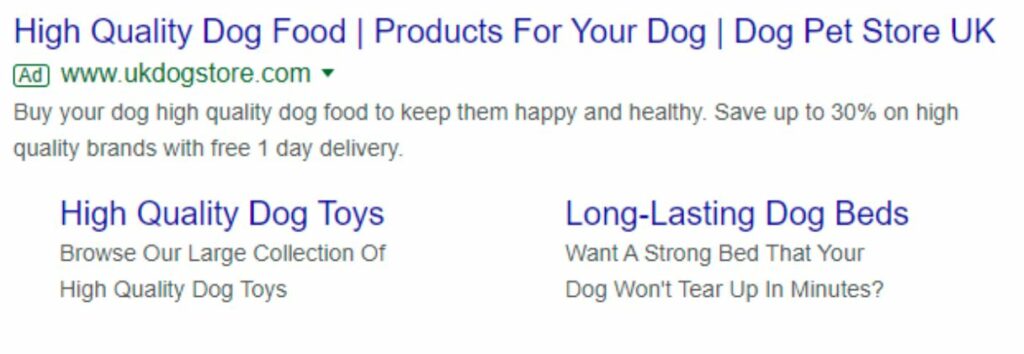
Call extensions can increase the amount of valuable leads your business gets, this is because talking to a real person can increase the chances of purchasing. Google will track call conversions using dynamic numbers too, so you can see which ads got a call, even if they had to dial it manually. This is useful for optimizing an ad account if a lot of sales come through by phone.
How We Help Clients Make Ad Extensions Effective?
Performance based digital marketing agency Atomic Leap works closely with our clients to understand their business goals and KPIs. This allows us to focus on maximising the engagement between the client and their customers, based on what the client wants and what their customers are looking for. This means that we can come up with campaigns to fit certain purposes, including making the ads as relevant as they can be with ad extensions to further improve the performance.
